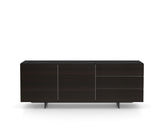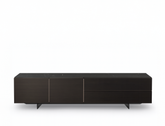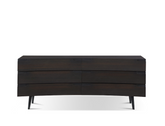Mastering Modern Furniture Style

When furnishing your home, whether you're starting fresh or updating your existing interior, you'll inevitably face the choice between modern and contemporary furniture. While these terms are often used interchangeably, they represent distinct styles with unique characteristics. Understanding the difference between modern and contemporary furniture design is key to making informed decisions that reflect your taste and meet your functional needs.
Modern vs. Contemporary Furniture Design: What's the Difference?
A common misconception is that modern and contemporary furniture designs are the same. However, this isn't the case. Contemporary design refers to the current trends, incorporating elements that are popular at any given time. It's a fluid style, evolving with new influences and ideas. Modern design, on the other hand, has its roots in a specific historical period, particularly the early to mid-20th century, and is characterized by certain features and design principles that distinguish it from other styles.
The Role of Modern Furniture in Interior Design
Defining Modern Interior Design
Modern interior design emerged in the late 19th century and developed through the 20th century, largely influenced by the modern art movement. This design philosophy emphasizes simplicity and function, where the form of furniture and decor is dictated by its purpose. Modern design strips away unnecessary details, leaving clean lines and uncluttered spaces that focus on utility. The minimalist approach inherent in modern design can be traced back to Scandinavian and German influences, which favor straightforward, practical furnishings over ornate decorations.
Key Characteristics of Modern Furniture
1. Minimalist Design
At the heart of modern furniture design is minimalism. This style is characterized by simple, clean lines and an absence of excessive decoration. Unlike contemporary styles that may incorporate a variety of design elements, modern furniture is pared down to its essentials, focusing on function and efficiency. This minimalist approach creates a sense of order and calm, making modern furniture ideal for those who prefer uncluttered spaces.
Modern furniture often features geometric shapes and streamlined forms, with an emphasis on straight, defined edges. This design language ensures that modern pieces remain timeless and sophisticated, transcending passing trends.
2. Neutral Color Palette
The color palette of modern furniture is another defining feature. Modern interiors are typically dominated by neutral tones, which contribute to a calm and cohesive atmosphere. Colors such as white, beige, grey, black, and earth tones are commonly used, creating a backdrop that allows the design elements to shine without overwhelming the space.
Even major furniture pieces like sofas, chairs, and bed frames are often found in these neutral shades. This contrasts with contemporary design, which may use bold colors as focal points or accents. In modern design, vibrant hues are used sparingly, primarily to highlight specific features without detracting from the overall simplicity.
3. Functionality Over Form
In modern design, functionality is paramount. Every piece of furniture is designed with a purpose in mind, often serving multiple functions to maximize space and utility. This approach is particularly beneficial in smaller homes or apartments, where space is at a premium.
Multifunctional furniture, such as storage beds, modular sofas, and extendable dining tables, are staples of modern design. These pieces not only serve practical purposes but also contribute to the visual harmony of a room, blending seamlessly with the overall aesthetic.
4. Cohesive Integration
A hallmark of modern interior design is the cohesive integration of furniture pieces. Rather than featuring a standout piece that draws attention, modern design emphasizes harmony and balance. Each element in a modern space is carefully chosen to complement the others, creating a unified look that feels intentional and well-curated.
This doesn't mean that individuality is lost—on the contrary, the simplicity of modern design allows for subtle distinctions in texture, material, and color that can add depth and interest to a space.
5. Use of Natural Materials
Modern furniture often incorporates natural materials such as wood, leather, and metal. These materials not only contribute to the aesthetic appeal of the furniture but also add durability and quality. Wood is frequently used for its warmth and versatility, while leather and metal provide a sleek, contemporary touch.
In addition to traditional materials, modern furniture sometimes includes elements of plastic or composite materials, particularly in pieces designed for practicality and ease of maintenance, such as stackable chairs.
6. Emphasis on Scale and Proportion
Modern design often features larger furniture pieces that make a statement without overwhelming the space. For instance, a large sectional sofa can anchor a living bed, providing both comfort and a focal point. However, it's important to balance these larger items with smaller, more functional pieces to maintain the overall harmony of the space.
When selecting modern furniture, consider the scale and proportion of each piece in relation to the room. This approach ensures that the furniture enhances the space without making it feel cramped or cluttered.
Styling Modern Furniture by Room
Modern Bedroom Furniture
In a modern bedroom, simplicity and comfort are key. Modern bedroom furniture often includes clean-lined beds, streamlined storage solutions, and subtle decorative elements that contribute to a serene environment. Wardrobes and storage beds are particularly popular, offering practical solutions to keep the space organized and free from clutter.
While modern design favors a neutral color palette, small pops of color can be introduced through bedding, artwork, or accessories to add personality and warmth to the room.
Modern Living Room Furniture
The living room is often the heart of the home, and modern design can enhance its functionality and aesthetic appeal. An open-plan layout is ideal for creating a sense of space and airiness, while a sectional sofa can define the living area and provide ample seating.
To achieve a cohesive look, consider using similar materials across the living and dining areas. For example, if your living room features a wooden coffee table, you might choose a dining table in the same wood tone to create a unified design. If space is limited, a neutral color scheme can make the room feel larger, while textured accessories like cushions, throws, and rugs add interest and warmth.
Modern Dining Room and Kitchen Furniture
Modern kitchens and dining rooms, especially in smaller homes or apartments, often benefit from an open-concept design. This approach not only maximizes space but also allows for a more seamless flow between cooking and dining areas.
Storage is a critical element in modern kitchen design. Modern cabinets and storage solutions are sleek and functional, avoiding unnecessary details that could disrupt the clean lines of the space. Dining tables in modern homes often feature high-quality materials like marble, sintered stone, or wood, paired with metal or steel legs for a contemporary look.
Dining chairs and benches in modern design are chosen for both their comfort and style, often incorporating a mix of materials and textures to add visual interest.
Frequently Asked Questions (FAQs)
1. What distinguishes modern furniture from contemporary furniture?
Modern furniture is characterized by its roots in a specific historical period, focusing on simplicity, clean lines, and functionality. Contemporary furniture, on the other hand, refers to the current design trends, which can incorporate a variety of styles and influences, including modern elements.
2. Can modern furniture be mixed with other styles?
Yes, modern furniture can be successfully mixed with other styles, such as traditional or industrial, to create an eclectic and personalized space. The key is to maintain balance and cohesion by choosing complementary colors, materials, and forms.
3. What materials are commonly used in modern furniture design?
Modern furniture often incorporates natural materials like wood, leather, and metal. These materials contribute to both the aesthetic appeal and durability of the furniture. Plastics and composites are also used, particularly for practical and versatile pieces.
4. How can I create a modern look in a small space?
To create a modern look in a small space, focus on functionality and simplicity. Choose multifunctional furniture that maximizes space, such as storage beds or modular sofas. Stick to a neutral color palette to make the space feel larger, and add texture and interest with accessories.
5. Is modern furniture comfortable?
While modern furniture is often associated with its minimalist and functional design, it does not compromise on comfort. Modern furniture is designed to be both practical and comfortable, with ergonomic forms and high-quality materials that ensure a pleasant user experience.
6. What are the best colors for a modern interior?
Neutral colors like white, beige, grey, black, and earth tones are the best choices for a modern interior. These colors create a calm and cohesive environment, allowing the furniture and design elements to stand out without overwhelming the space. Accents of color can be introduced through accessories and artwork to add personality and interest.
Conclusion
Modern furniture design offers a timeless approach to decorating your home, emphasizing simplicity, functionality, and the use of natural materials. Whether you're furnishing a new space or updating your existing decor, understanding the elements of modern design can help you create a home that is both stylish and functional. By focusing on clean lines, neutral colors, and multifunctional pieces, you can achieve a modern look that will remain sophisticated and relevant for years to come.
Ready to design a modern room? Check out Prestige Affairs online catalogue of high-quality modern furniture in Singapore, all at affordable prices! Shop in the convenience of your home.







